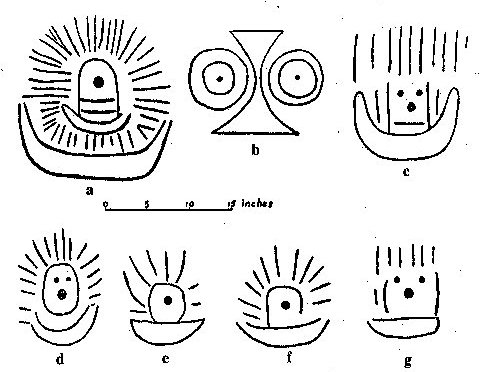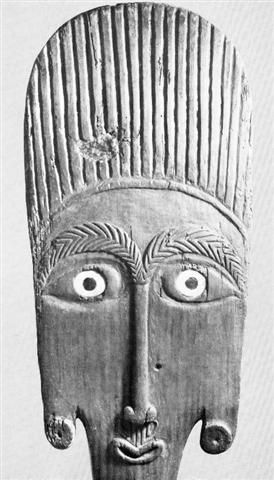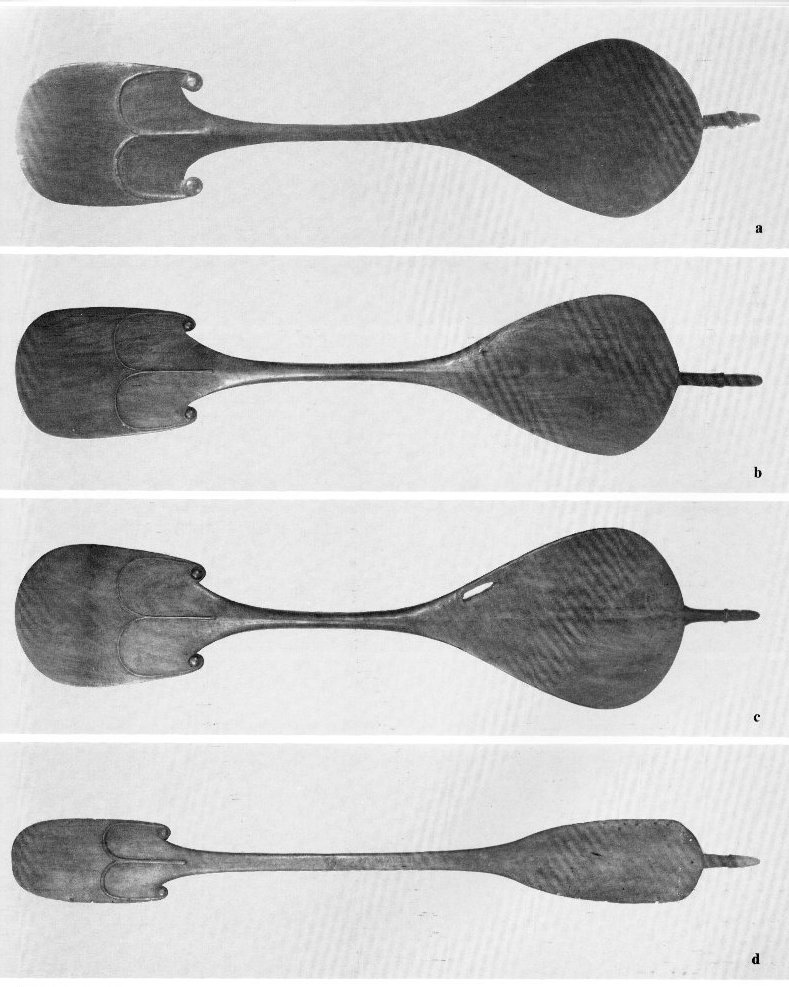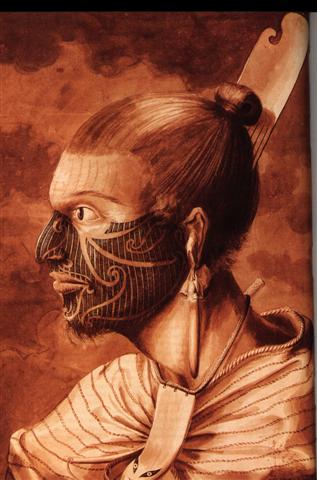|
TRANSLATIONS
The beginning of hau tea in the glyph dictionary:
|
A few preliminary
remarks and imaginations:
1.
The beams of the sun which enlighten
our world:

presumably form the bottom part of the hau tea glyph type. This way of illustrating
- with the rays depicted as straight lines -
is the same as in the petroglyphs below (ref. Heyerdahl 3):

The vertical sun rays are also seen on the upper part of an example
of
ao:
:
"A large portion of the upper blade, corresponding to
the broad and tall forehead, is covered by dense rows of vertically
painted stripes that may indicate hair although in some specimens
they definitely assume the aspects of a feather-crown of the type
common in aboriginal Easter Island." (Heyerdahl 3) |
| Ao, aô Large dance paddle.
1. Command, power, mandate, reign: tagata
ao, person in power, in command, ruler. 2. Dusk, nightfall. 3. Ao
nui, midnight. 4. Ao popohaga, the hours between midnight and
dawn. Aô, to serve (food); ku-âo-á te kai i ruga i te kokohu,
the food is served on a platter. Vanaga.
1. Authority, kingdom, dignity, government, reign (aho);
topa kia ia te ao, reign; hakatopa ki te ao, to confer
rank; ao ariki, royalty; ka tu tokoe aho, thy kingdom
come. PS Mgv.: ao, government, reign. Mq.: ao, government,
reign, command. Sa.: ao, a title of chiefly dignity; aoao,
excellent, surpassing, supreme. 2. Spoon; ao oone, shovel. 3. Dancing club
T. 3. Aonui (ao-nui 2), midnight. 4. Pau.: ao, the
world. Mgv.: ao, id. Ta.: ao, id. Mq.: aomaama, id.
Ma.: ao, id. 5. Pau.: ao, happy, prosperity. Mgv.: ao,
tranquil conscience. Ta.: ao, happiness. 6. Mgv.: ao,
cloud, mist. Ta.: ao, id. Mq.: ao, id. Sa.: ao,
cloud. Ma.: ao, id. 7. Mgv.: ao, hibiscus. 8. Ta.: ao,
day. Mq.: ao, day from dawn to dark. Sa.:
ao, id. Ma.: ao, id. 9. Ta.: ao, a bird. Ha.: ao, id.
10. Mq.: ao, respiration, breath. Ha.: aho, breath. 11.
Mq.: ao, to collect with hand or net. Sa.: ao, to gather.
Ma.: ao, to collect. Ta.: aoaia, to collect food and other
things with care. Churchill. |
| "The ao and rapa
differ from each other mainly in size and in decoration, but are
otherwise closely related. Both were double-bladed paddles twirled
and shaken in the hand during ceremonial dances. The ao was
the larger of the two types, with a total length that could exceed 6
ft. (2 m.). One blade of the paddle, usually
pointing up during dances, has a conventionalized human face carved
and painted on each of its sides. The blade itself is carved flat as
on a functional paddle, with almost parallel edges and a rounded
distal end.
The nose is very long and extremely narrow, and
forks into two prominent eyebrows. This curved, Y-shaped combination
of nose and eyebrows is slightly raised in relief. The eyes are
carved and painted much larger than the mouth, which is either
reduced to a minimum or lacking. The ears, however, are invariably
present and carved in a conventionalized manner as two downward
projecting lobes with circular earplugs.

One very old and worm-eaten sample (Boston
64845) has fish vertebrae inserted as earplugs. The specimen,
collected by Agassiz' Albatross Expedition as late as 1904-5, has
doubtless been kept hidden in a cave. A large portion of the upper
blade, corresponding to the broad and tall forehead, is covered by
dense rows of vertically painted stripes that may indicate hair
although in some specimens they definitely assume the aspects of a
feather-crown of the type common in aboriginal Easter Island.
Some specimens have vertical tear marks painted as
parallel stripes running from the bases of the large eyes down
across the chin. This 'weeping-eye' motif is particularly pronounced
on the ancient ao symbols preserved as mural paintings on the
slabs in the ceremonial houses of Orongo (Ferdon, 1961, Figs.
65 b, f and Pl. 29 c; this vol., 183 a). Some faces on ao
paddles are painted with geometric fields suggesting tattoo.

Only one twin-faced blade of the ao is
painted; the rest of the paddle is left polished and plain. A slim
handle with an oval cross-section that becomes almost circular at
mid-length connects the painted blade with the other one which is
undecorated. It has the same outline except for the lack of
indentations carved below the earlobes of the decorated blade.
In some specimens the second blade is slightly
narrower and has a rounded rectanguloid outline. A fingerlike
projection with a ring-shaped band in relief around its midsection
is sometimes, but not always, carved at the center of the distal end
of this second blade. In some specimens the ring is replaced by a
steplike transition from a wider upper part to a narrower lower
part. This extension corresponds to the knob carved elsewhere on
some functional paddles and serves for pushing off or staking
operations." (Heyerdahl 3) |
The undecorated bottom paddle blade
presumably is female, while the top decorated one is male. Cocks have gaudy
colours, hens not.
Next page:
|
2.
Considering why there always are 3 vertical 'beams' in
hau tea - it must have a meaning - and based on the assumption
that it is sun beams which are illustrated, the natural conclusion will be that
the three 'beams' indicate
the division of the
day: "The
Hawaiian day was divided in three general parts, like that of the early Greeks
and Latins, - morning, noon, and afternoon - Kakahi-aka, breaking the
shadows, scil. of night; Awakea, for Ao-akea, the plain
full day; and Auina-la, the decline of the day.
The lapse of the night, however, was
noted by five stations, if I may say so, and four intervals of time, viz.: (1.)
Kihi, at 6 P.M., or about sunset; (2.) Pili, between sunset and
midnight; (3) Kau, indicating midnight; (4.) Pilipuka, between
midnight and surise, or about 3 A.M.; (5.) Kihipuka, corresponding to
sunrise, or about 6 A.M. ..." (Fornander)
Time consisted of night + day = 4 + 3 = 7. The Polynesians considered the
origin was in the darkest of night, with light arriving only later:
|
Night |
Kihi (sunset) |
|
| |
Pili |
| Kau
(midnight) |
|
| |
Pilipuka |
|
Kihipuka
(sunrise) |
|
|
Day |
Kakahi-aka |
morning |
|
Awakea |
noon |
|
Auina-la |
afternoon |
Fornander is not clear as to how the
night was structured in Hawaii, but 4 intervals of time there were. I have put midnight in a
special (black) box because it marks the 'death' of the old day (and the birth
of a new day). The division ('cut') of time at midnight makes it natural to have
a balance with 2 intervals before and 2 intervals after. There is no similar
'cut' at noon. Time begins anew (with a new cycle) at the darkest place.
Pilipuka is the first 'season' of the day and Pili the 7th. |
Hawaiian is harder to read than
other Polynesian dialects because they removed 't' from their alphabet. Kau
(midnight) could mean tau ('season') but also kau (swim), both
of which are reasonable. In the darkest of times there is no visible land
and you have to swim, and to mark the important border between one day and
the next a stone (tau) is used.
Words from 'foreign' Polynesian
dialects may have been preserved on Easter Island. Churchill's word list for
Mangareva, I have noticed, often is helpful, and the south - north travels
with Marquesas in the center, Hawaii in the north and Easter Island in the
south may have been more frequent than other trips across the sea, at least
during the later times when the Easter Polynesian dialects were being established
in the Pacific.
The 7th 'station', Pili, on
the other hand, is easy to transcribe into Rapanui:
| Piri
1. To join (vi, vt); to meet someone on the road;
piriga, meeting, gathering. 2. To choke: he-piri te
gao. 3. Ka-piri, ka piri, exclamation: 'So many!'
Ka-piri, kapiri te pipi, so many shellfish! Also used to
welcome visitors: ka-piri, ka-piri! 4. Ai-ka-piri ta'a
me'e ma'a, expression used to someone from whom one hopes to
receive some news, like saying 'let's hear what news you bring'.
5. Kai piri, kai piri, exclamation expressing: 'such a
thing had never happened to me before'. Kai piri, kai piri,
ia anirá i-piri-mai-ai te me'e rakerake, such a bad thing
had never happened to me before!
Piripiri, a slug found on the coast,
blackish, which secretes a sticky liquid.
Piriu, a tattoo made on
the back of the hand. Vanaga.
1. With, and. 2. A shock, blow. 3. To stick
close to, to apply oneself, starch; pipiri, to stick,
glue, gum; hakapiri, plaster, to solder; hakapipiri,
to glue, to gum, to coat, to fasten with a seal;
hakapipirihaga, glue. 4. To frequent, to join, to meet, to
interview, to contribute, to unite, to be associated,
neighboring; piri mai, to come, to assemble, a company,
in a body, two together, in mass, indistinctly; piri ohorua,
a couple; piri putuputu, to frequent; piri mai piri
atu, sodomy; piri iho, to be addicted to; pipiri,
to catch; hakapiri, to join together, aggregate, adjust,
apply, associate, enqualize, graft, vise, join, league, patch,
unite. Piria;
tagata piria, traitor. Piriaro
(piri 3 - aro), singlet, undershirt.
Pirihaga, to ally,
affinity, league. Piripou
(piri 3 - pou), trousers.
Piriukona, tattooing on
the hands. Churchill. |
To join, assemble (in mass), is one
of the meanings of piri. To stick together like the blackish slugs (piripiri)
on the coast (presumably the south coast) reminds us about Te Piringa
Aniva, the 7th kuhane station (if Maunga Hau Epa is
regarded as number 1) in the dark time when all the people gathered close
together, presumably to help nature in delivering the new 'fire' (first Sirius,
Te Pou, and later on sun). The structure is the same as that in the Hawaiian night.
It is a sluggish (slow and
irregular) time:
| Niva
Nivaniva,
madman, idiot. Vanaga.
Nivaniva,
absurd, stupidity, bungler, delirium, madness, to err, to wander
in mind, folly, foolish, heedless, frenzied, imbecile,
senseless, odd, inconsistent, simple, dupe, stupid, flighty (nevaneva);
nivaniva o te mata,
lethargy. Hakanivaniva,
queer, bewitched, stupefied, to tell lies. PS Ta.:
nivaniva,
neneva, foolish,
stupid, mad. Sa.: niniva,
giddy, dizzy. Churchill |
The people (aniva) is like
a mob, they can make the sun mobile again. Word play makes us understand.
In the beginning the gods were
like slugs, we should remember from the Haida:
|
Aanishaw
tangagyanggang, wansuuga. |
Hereabouts was all
saltwater, they say. |
|
Li
xitgwaangas, Xhuuya aa. |
He was flying all
around, the Raven was, |
|
Tigu
qqawgashlingaay gi lla quaangas. |
looking for land
that he could stand on. |
|
Qawdihaw gwaay
ghutgwa nang qaadla qqaayghudyas, |
After a time, at
the toe of the Islands, there was one rock awash. |
|
llagu qqawghaayghan
llagha lla xiidas. |
He flew there to
sit. |
|
|
|
Aa ttl sghaana
quiidas yasgagas ghiinuusis gangaang |
Like sea-cucumbers,
gods lay across it, |
|
llagu
gutgwii xhihldagahldiyaagas. |
putting their
mouths against it side by side. |
|
Ga sghaanagwaay
ghaaxas lla ttista qqaa sqqagilaangas, |
The newborn gods
were sleeping, out along the reef, |
|
ttl gwiixhang
xhahlgwii at wagwii aa. |
heads and tails in
all directions. |
|
Ghaadagas gyaanhaw
ising ghaalgagang, wansuuga ... |
It was light then,
and it turned to night, they say ... |
It must be a joke what comes at
the end, because obviously it was night then, and it turned to day. Light is
a word play on night.
The heads and tails (as if
flipping a coin, also a random event) of the
'cucumbers' were in all directions, describing the disorder before light
was 'turned on'.
The 'toe' on which Raven
'alighted' possibly indicates Hanga Te Pau - at least it is a kind of last station. Its
opposite should be at the other 'end' of the 'body', viz. at the 'snout':
| Ihu
1. Nose; ihu more, snub nose, snub-nosed
person. 2. Ihuihu cape, reef; ihuihu - many reefs,
dangerous for boats. 3. Ihu moko, to die out (a family of
which remains only one male without sons); koro hakamao te
mate o te mahigo, he-toe e-tahi tagata nó, ina aana hakaara,
koîa te me'e e-kî-nei: ku-moko-á te ihu o te mahigo, when
the members of family have died and there remains only one man
who has no offspring, we say: ku-moko-á te ihu o te mahigo.
To disappear (of a tradition, a custom), me'e ihu moko o te
tagata o te kaiga nei, he êi, the êi is a custom no
longer in use among the people of this island. 4. Eldest child;
first-born; term used alone or in conjunction with atariki.
Vanaga.
1. Nose, snout, cape T (iju G). Po
ihuihu, prow of a canoe. P Pau.: ihu, nose. Mgv.:
ihu, nose; mataihu, cape, promontory. Mq., Ta.:
ihu, nose, beak, bowsprit. Ihupagaha, ihupiro,
to rap on the nose, to snuffle. 2. Mgv.: One who dives deep.
Ta.: ihu, to dive. Churchill.
Sa.: isu, nose, snout, bill. Fu.,
Fakaafo, Aniwa, Manahiki: isu, the nose. Nuguria;
kaisu, id. Fotuna: eisu, id. Moiki: ishu, id.
To., Niuē, Uvea, Ma., Ta., Ha.,
Mq., Mgv., Pau., Rapanui, Tongareva, Nukuoro: ihu,
id. Rarotonga: putaiu,
id. Vaté: tus, id.
Viti: uthu, nose.
Rotumā: isu, id. ...
usu and
ngusu ... serve as transition
forms, usu pointing
to isu the nose in
Polynesia and ngusu
to ngutu the mouth,
which is very near, nearer yet when we bear in mind that
ngutu the mouth is snout as
well and that isu the
nose is snout too ...
Churchill 2. |
The name of the first Hawaiian
station, Pilipuka, ought to be pili-puka, and puka
maybe should be read as puta, cfr Rarotongan putaiu for
'nose', the 'nose' which has perforated (tiputa) the dark cloth,
I suppose:
| Tiputa
Pau.: To bore, to perforate. Ta.: tiputa,
to pierce. Mq.: tiputa, id. Ha.: kipuka, an
opening. Churchill |
The ti plant could
symbolize rebirth, we have learned from poporo.
Then we have rei puta, a
whale bone 'saviour of life':

The picture is from
Starzecka and shows the tattooed son of a Maori chief.
| Rei
1. To tread, to trample on: rei kiraro ki te
va'e. 2. (Used figuratively) away with you! ka-rei kiraro
koe, e mageo ê, go away, you disgusting man. 3. To shed
tears: he rei i te mata vai. 4. Crescent-shaped breast
ornament, necklace; reimiro, wooden, crescent-shaped
breast ornament; rei matapuku, necklace made of coral or
of mother-of-pearl; rei pipipipi, necklace made of
shells; rei pureva, necklace made of stones. 5. Clavicle.
Îka reirei,
vanquished enemy, who is kicked (rei). Vanaga.
T. 1. Neck. 2. Figure-head.
Rei mua = Figure-head in
the bow. Rei muri =
Figure-head in the stern. Henry.
Mother of pearl;
rei kauaha, fin. Mgv.:
rei, whale's tooth.
Mq.: éi, id. This is
probably associable with the general Polynesian
rei, which means
the tooth of the cachalot, an object
held in such esteem that in Viti one tooth (tambua)
was the ransom of a man's life, the ransom of a soul on the
spirit path that led through the perils of
Na Kauvandra to the
last abode in Mbulotu.
The word is undoubtedly descriptive, generic as to some
character which Polynesian perception sees shared by whale ivory
and nacre. Rei kauaha
is not this rei; in
the Maori whakarei
designates the carved work at bow and stern of the canoe and
Tahiti has the same use but without particularizing the carving:
assuming a sense descriptive of something which projects in a
relatively thin and flat form from the main body, and this
describes these canoe ornaments, it will be seen that it might
be applied to the fins of fishes, which in these waters are
frequently ornamental in hue and shape. The latter sense is
confined to the Tongafiti migration.
Reirei, to trample down, to knead, to
pound. Churchill.
Pau.: Rei-hopehopega, nape. Churchill.
Mg. Reiga, Spirit leaping-place. Oral
Traditions. |
Now we are prepared to read about
the names of stars. Makemson:
"473. Pili-lua,
Two-friends-close-together; the Hawaiian form of Pipiri or Pipili,
whose myth is told throughout the Polynesian area. The Hawaiian pair of
stars was supposed to bring the opelu fish to local waters."
Maybe opelu
is o-pelu, and pelu = to fold, double over. If so, then there
will be - in a way - 'two friends close together'.
| Peu
1. Axe, adze, mattock;
peu pakoa,
an axe poorly helved. 2. Energy. Peupeu:
1. To groan. 2. To be affectionate, to grow tender;
peupeuhaga,
friendship. Mq.: pèèhu,
haápeéhu,
pekehu,
to make tender. 3. Pau.: peu,
habit, custom, manners. Ta.: peu,
custom, habit, usage. 4. Pau.: hakapeu,
to strut. Ta.: haapeu,
id. Churchill.
Sa.:
mapelu,
to bend, to stoop, to bow down, persons stooping with age,
housebeams sagging under weight. To.:
pelu,
bebelu,
to fold, to crease. Fu.: pelu,
peluki,
to fold. Uvea: pelu,
id., mapelu,
to bend, to bow. Ha.: pelu,
to double over, to bend, to fold. Rapanui:
peu,
axe, adze. Churchill 2. |
Te Peu
(significantly on the western coast close to the end of the kuhane
journey) is where Tuu Ko Ihu buried the head of Hotua Matua.
He was intending to be the 'nose' (ihu), the new boss.
Gemini, we can conclude, means the two friends close together
- one representing one side of the fold of time, the other the other side of
the fold. Spring equinox once was located in Gemimi.
"476. Pipili-ma, the Twins; a name for Lambda and
Upsilon Scorpii in Pukapuka.
477. Pipiri is the Maori name for the celebrated twins
who became stars. They are described as 'two stars of low rank', probably
referring to the degree of brightness, which rise shortly before the
Pleiades and herald the approach of the illustrious cluster and hence of a
new year Some
Maori tribes called the first month of the year Te Tahi-o-Pipiri, the
First of Pipiri, or by the abbreviated form Opipiri. Pipiri
was thus a synonym for winter, like Takurua, Sirius.
The Mangaians called the third month of the winter season
Pipiri. In Mangareva Pipiri was June, while in Easter Island it
stood for December.
Makemson can hardly have misunderstood, because the close (in
text and geography) Mangarevans had Pipiri properly located in June.
Maybe her source had misunderstood - on Easter Island Pipiri ought to
refer to 'December' rather than to December.
From the description it is evident that the Maori Pipiri
is the constellation Aries, which consists of two stars on the same diurnal
path as the Pleiades. In the Society Islands, Tuamotus and Pukapuka
Pipiri is identified as a double star in Scorpius, while in the Hawaiian
Islands Pililua is said to be Castor and Pollux.
Pipiri also appears in the form Oipiri.
According to a half-forgotten Maori myth, Oipiri and Whaka-ahu,
Castor, were the daughters of Po, Night, and Ao, Day. They
both became wives of Rehua. Oipiri was well versed in matters
pertaining to night and winter and she produced the snow. Whaka-ahu
was associated with summer and the world of light, marama heko-heko.
As night and day, cold and heat, summer and winter continually vie with one
another, so the attendants of Oipiri and Whaka-ahu are engaged
in an eternal conflict, but neither gains a permanent victory."
There is more in Makemson about pipiri, but this ought to be enough
for the moment. The main point is clear: Pipiri is an important
marker for a change of season.
|




